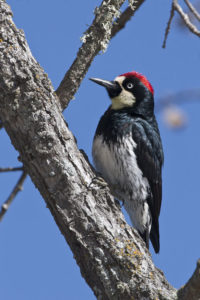
Climate change will, ultimately, affect every creature on this planet.
And the changes will be more complex and multi-layered than most of us can comprehend – at least until we see them with our own eyes.
I was reminded of this recently while reading a trio of research reports about acorn woodpeckers, a wondrous species common along the Pacific Coast and in the southwestern United States.
Known best for the incredible granaries they create in tree trunks (sometimes storing as many at 50,000 acorns in a single tree), these woodpeckers could meet their end because of global warming.
And the phenomenon that could doom acorn woodpeckers could do the same to a host of bird species.
Cornell University ornithologist Walt Koenig laid out the scenario in a research paper and subsequent mass-market article on climate change and acorn woodpeckers for The Cornell Lab’s “All About Birds” website.
Acorn woodpeckers turn trees, and even telephone poles and wooden siding, into granaries for storing a year’s acorn crop. They bore into the wood, creating an acorn-sized hole, then push the nut into positions. Hundreds or thousands of acorns can be deposited into the trunk of a host tree. And the best granaries are used year after year by the same birds.
Storing these acorns is a critical pursuit. In the warm, moist climates acorn woodpeckers call home, it isn’t possible to simply create a stash of acorns; it’s too wet and moldy. So the granaries are essential. And, of course, so is any given year’s acorn crop.
The problem for acorn woodpeckers is the natural phenomenon called “spatial synchrony.”

Photo by Marlin Harms.
Here’s a refresher from Koenig:
“The concept of synchrony is one we are all familiar with: periodical cicadas emerge once every 13 or 17 years in the eastern and midwestern United States; swarms of fireflies are known to flash at same time in Southeast Asia; different plants may flower simultaneously each spring in a particular area.
“Spatial synchrony adds the component of distance to the concept of synchrony, and refers to the idea that the size or density of different populations of plants or animals has a tendency to be correlated through time and space. For example, if spatial synchrony is high, then when one population is relatively large, nearby populations are relatively large as well; when a population is small, nearby populations are small too.
“Spatial synchrony turns out to be a nearly universal characteristic of populations and is particularly important when thinking about species survival and conservation.”
Here’s where climate change enters the picture.
“Both temperature and rainfall exhibit spatial synchrony over distances of up to 1,000 miles or more over all of North America and, indeed, the planet,” according to Koenig. “In other words, in years when it’s relatively cold here at the Cornell Lab of Ornithology in Ithaca, New York, it’s likely to also be relatively cold in Minneapolis, Minnesota, about 1,000 miles to the west, and in Atlanta, Georgia, nearly 1,000 miles south, even though the climate of those sites — particularly Atlanta — is considerably different than in Ithaca.”
In his research, which looked at the time period from 1960 to 2009, Koenig found significant increases in spatial synchrony of average maximum temperatures across North America.
So not only is the temperature getting warmer, when it’s a relatively warm year in one place, it’s now more likely to be a relatively warm year across the continent.
Here’s why that’s important:
“When bird populations are spatially synchronous, they are at higher risk of extinction,” Koenig realized. “That’s because when temperatures and food resources are different enough from one area to another, birds may fail in one area, but their populations can recover if birds from areas with better conditions are able to move in. This ‘population rescue’ effect has been invoked as being important to the long-term persistence of a variety of taxa, including birds.
“In contrast, when spatial synchrony is high, it means that when one area fails, others are likely to fail too, because there may not be enough birds to recolonize other areas. Consequently, when spatial synchrony is high, there is a relatively high likelihood of global extinction.”
In the case of acorn woodpeckers, global warming could be devastating.
Oak trees produce acorns synchronously, with many trees in the same area yielding acorns at the same time, according to Koenig. The size of the crop varies considerably from year to year, though, so woodpeckers adjust by relocating to another, more distant forest of oaks.
The extensive spatial synchrony associated with global warming, though, means that when the acorn crop fails in one forest, the same will likely true in every forest where the woodpeckers might relocate.
Thus Koenig’s warning:
“The bottom line is that global climate change is adversely affecting many North American bird populations in subtle ways by altering the probability of population rescue in addition to the more obvious ways by altering distributions and habitats.”
Read more about this phenomenon, acorn woodpeckers and Koenig’s research at these links:
“Temporally increasing spatial synchrony of North American temperature and bird populations”. Nature Climate Change doi:10.1038/nclimate2933. By W. D. Koenig and A. M. Liebhold.
“Why global climate change may be putting more birds in the same basket” by Walt Koenig, Cornell University Lab or Ornithology, allaboutbirds.org.
“Acorn woodpeckers hoard thousands of acorns in a single tree” by Tao Tao Holmes, atlasobscura.com.

Leave a Reply